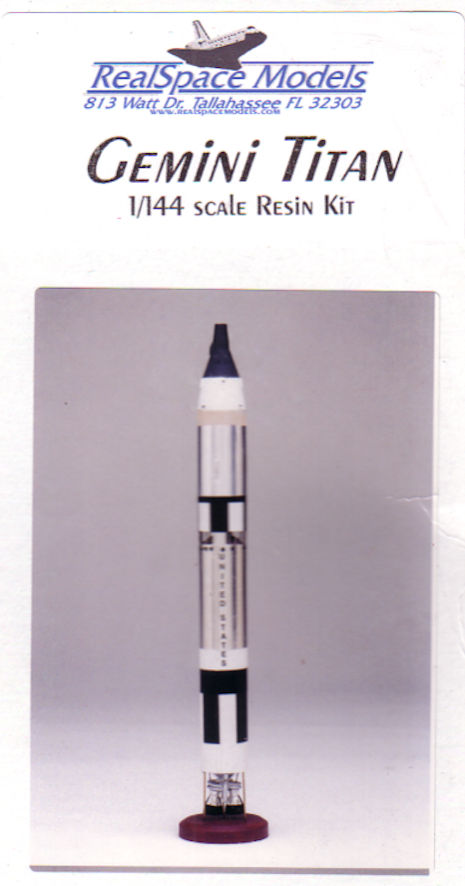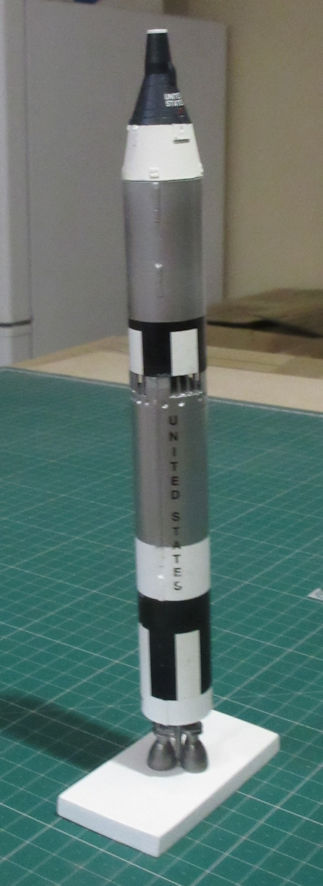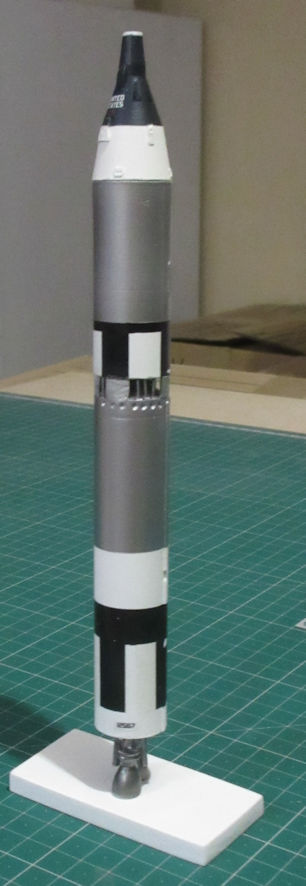The Titan was the United States’ second generation Intercontinental Ballistic Missile. Development began in October 1955 before the first generation Atlas missiles had been test flown. The Titan had two stages and could deliver much heavier payloads of atomic weapons more accurately over greater distances. The first Titan was delivered in June 1958 and flown in February 1959. The missiles were housed in hardened underground silos and became operational in 1962.
Development of the advanced Titan II began in 1958. It had even greater lifting power and greater range, and used fuels that could be stored in the missiles for long durations so they could be launched virtually instantaneously. By 1965 all the original Titan had been replaced by Titan IIs, and over 140 were manufactured and deployed in six squadrons at bases in Arizona, Arkansas and Kansas. They remained on alert for 25 years, the final ones being decommissioned in 1987.
When President Kennedy announced, on 25 May 1961, the objective of sending a man to the Moon before the end of the 1960s there were many theoretical and practical problems to be solved to achieve the objective. The announcement was made only a couple of weeks after the first Mercury-Redstone sub-orbital flight and techniques and equipment had to be developed to overcome those problems so the President’s goal could be achieved. Two of the most pressing were developing ways of manoeuvring in space to link spacecraft and the ability for astronauts to work outside spacecraft. These challenges were beyond the capabilities of Project Mercury and so a follow-on, Project Gemini, was initiated.
A new, larger vehicle was developed, along the same lines as the Mercury capsule but capable of carrying two astronaut and able to remain in space for two weeks. This was achieved by adding a Service Module to the Gemini capsule, equipped with the necessary services, including fuel cells, to support longer duration flights. NASA announced plans for an enhanced manned space program in December 1961 and named it Project Gemini in January 1962. Basic design of the Gemini capsule was led by a Canadian, Jim Chambarlain, who went to NASA along with another 25 Canadian engineers after the Canadian government had cancelled the Avro Arrow project.
 The Titan II was selected as the Project Gemini launch vehicle and existing missiles were modified to launch the Gemini capsules. The modifications included adaptions to stage 2 for the Gemini service module and the addition of safety equipment to make it suitable for manned flight. Three Project Mercury astronauts, Cooper, Grissom and Schirra went on to Project Gemini and another 13 were selected for the new project. Twelve Gemini-Titan II missions were flown between April 1964 and November 1966. The first two flights were unmanned to test the system and the first manned flight, Gemini III, took place on 23 March 1965.
The Titan II was selected as the Project Gemini launch vehicle and existing missiles were modified to launch the Gemini capsules. The modifications included adaptions to stage 2 for the Gemini service module and the addition of safety equipment to make it suitable for manned flight. Three Project Mercury astronauts, Cooper, Grissom and Schirra went on to Project Gemini and another 13 were selected for the new project. Twelve Gemini-Titan II missions were flown between April 1964 and November 1966. The first two flights were unmanned to test the system and the first manned flight, Gemini III, took place on 23 March 1965.
Gemini III was a flight to test the systems and lasted only three orbits. The next flight, Gemini IV, lasted four days and included the first American extra vehicular activity (EVA). Gemini V, launched in August 1965, lasted almost eight days and tested the fuel cells, guidance and navigation systems for future rendevous missions. Gemini VI had to be abandoned when the vehicle it was to rendevous with failed but, during Gemini VII flight of 13 days, launched in December 1965, a redefined Gemini VIA flight was launched so that it and Gemini VII rendezvoused in orbit and flew in formation for five hours, getting within a foot of each other. Gemini VIII, launched in March 1966, accomplished the first space docking but a malfunction caused uncontrollable spinning and the Gemini made an emergency landing after only ten hours. The final four Gemini flights lasted between two and three days and perfected the techniques necessary for a flight to the moon, including dockings and EVAs. The final Gemini flight, Gemini XII, from 11 to 15 November 1966, achieved all the objectives of Project Gemini which was then concluded. It cleared the way for Project Apollo to send men to the moon.
The Titan continued in service following Project Gemini. In 1962 the United States Department of Defence announced development of the Titan III as a space launch vehicle and the first one was flown in September 1964. A more efficient version, the Titan IIIB was developed and 59 were launched with a variety of payloads between 1966 and 1987. Titan IIIs were also developed with strap-on boosters and a total of 84 were launched between 1965 and 1992. A more advanced version, the Titan IVA was first launched in 1989 and the Titan IVB in 1997. The final Titan IVB was delivered in early 2002 and launched in 2003, the Titan being phased out in favour of an advanced launcher based on the older Atlas launchers. In all, there were 350s Titan launches over more than 40 years and the docking manoeuvres developed during Project Gemini continue to be an important aspect of manned space flights.
For my money the Gemini-Titan II is the most elegant of the early space craft. It’s really nothing more than a long tube with a capsule on one end and rocket motors on the other, but it looks like it means business. When Revell released their combined Mercury and Gemini capsules in 1:48 in the early 1960s I began thinking about making the Titan to go with the Gemini but the rocket motors were too hard for me then. When I discovered the New Ware web site that sold Mercury-Redstone and Mercury-Atlas kits I was disappointed they didn’t do a Gemini-Titan II as well, but a little later I discovered Real Space Models. It’s an American company that has a fairly interesting range of space craft and rockets, including the Gemini-Titan II. When the kit arrived I was a little disappointed. The moulding is not quite to the standard of New Ware and there are a few bubbles in the resin at embarrassing places but, most disappointing of all, there was no attempt to replicate the corrugations that were a distinctive feature of the Mercury and Gemini capsules. The rocket motors at the end of the tube are also rather indistinctly moulded, but it’s not an insurmountable problem.
There’s not much to say about assembling this kit which has only four parts, 20 if you include the little pieces of plastic rod needed between the stages and to support the motors. The painting instructions aren’t entirely accurate (I have yet to see a picture of a Gemini-Titan II with a tan band between the service module and the rocket) but the decals go on nicely. With the mixture of bare metal, white and black, the completed model looks about as nice as I expected it would.

Leigh Edmonds
December 2006

